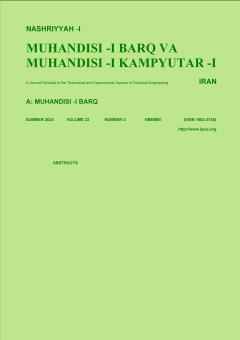مدلسازی نیروگاه خورشیدی با استفاده از شبکه عصبی مبتنی بر مدار معادل تکدیود
الموضوعات : electrical and computer engineering
علیرضا رئیسی
1
![]() ,
روح اله عبداللهی
2
,
روح اله عبداللهی
2
1 - گروه مهندسی برق، دانشگاه ملی مهارت تهران
2 - گروه مهندسی برق، دانشگاه ملی مهارت تهران
الکلمات المفتاحية: مدلسازی, نیروگاه خورشیدی, شبکه عصبی, مدار معادل تکدیود,
ملخص المقالة :
روشهای مختلفی جهت مدلسازی پنلهای خورشیدی ارائه شده است؛ اما مدلسازی نیروگاه خورشیدی با استفاده از آنها با چالشهایی همراه میباشد. مدلسازی در روشهای مبتنی بر مدار معادل، وابسته به دادههای کارخانه سازنده است که با گذر زمان تغییر میکنند. مدلسازی مشخصه ولتاژ– جریان با استفاده از روشهای هوشمند مانند شبکه عصبی به علت دقت پایین مدلسازی کمتر مورد توجه قرار گرفت. در این مقاله، روشی مستقل از دادههای کارخانه سازنده جهت مدلسازی نیروگاه خورشیدی ارائه میشود؛ چنان که امکان مدلسازی دقیق نیروگاههای خورشیدی چند سال نصبشده نیز فراهم میباشد. روش پیشنهادی شامل دو مرحله است؛ در مرحله اول ولتاژ مدار باز، نقطه حداکثر توان و جریان اتصال کوتاه برحسب شرایط جوی با استفاده از شبکه عصبی مدل میشوند. در مرحله دوم پارامترهای مجهول مدار معادل توسط روابط تحلیل مداری و با استفاده از خروجیهای شبکه عصبی تعیین میشوند. نهایتاً جهت ارزیابی روش پیشنهادی، مدلسازی یک نیروگاه خورشیدی 3 کیلووات انجام شد که نتایج، دقت مناسب روش پیشنهادی جهت مدلسازی نیروگاه خورشیدی را نشان میدهند.
[1] D. C. Jordan and S. R. Kurtz, "Field performance of 1.7 GW of photovoltaic systems," IEEE J. of Photovoltaics, vol. 5, no. 1, pp. 243-249, Jan. 2015.#
[2] M. Brenna, F. Foiadelli, M. Longo, and D. Zaninelli, "Energy storage control for dispatching photovoltaic power," IEEE Trans. on Smart Grid, vol. 9, no. 4, pp. 2419-2428, Jul. 2018.#
[3] S. Hara, H. Douzono, M. Imamura, and Tatsuya Yoshioka, "Estimation of photovoltaic cell parameters using measurement data of photovoltaic module string currents and voltages," IEEE J. of Photovoltaics, vol. 12, no. 2, pp. 540 -545, Mar. 2022.#
[4] M. Ma, et al., "Photovoltaic module current mismatch fault diagnosis based on I-V data," IEEE J. of Photovoltaics, vol. 11, no. 3, pp. 779-788, May 2021.#
[5] K. Kamil, K. H. Chong, and H. Hashim, "Excess power rerouting in the grid system during high penetration solar photovoltaic," Electric Power Systems Research, vol. 214, Pt. A, Article ID: 108871, Jan. 2023.#
[6] P. Chao, et al., "A comprehensive review on dynamic equivalent modeling of large photovoltaic power plants," Solar Energy, vol. 210, pp. 87-100, Nov. 2020.#
[7] G. Ciulla, V. L. Brano, V. D. Dio, and G. Cipriani, "A comparison
of different one-diode models for the representation of I-V characteristic of a PV cell," Renewable and Sustainable Energy Reviews, vol. 32, pp. 684-696, Apr. 2014.#
[8] A. Mellit and S. A. Kalogirou, "Artificial intelligence techniques
for photovoltaic applications: a review," Progress in Energy and Combustion Science, vol. 34, no. 5, pp. 574-632, Oct. 2008.#
[9] K. Garud, S. Jayaraj, and M. Lee, "A review on modeling of solar photovoltaic systems using artificial neural networks, fuzzy logic, genetic algorithm and hybrid models," International J. of Energy Research, vol. 45, no. 1, Article ID: 5608, 2020.#
[10] F. Almonacid, C. Rus, L. Hontoria, M. Fuentes, and G. Nofuentes, "Review, characterisation of si-crystalline PV modules by artificial neural networks," Renewable Energy, vol. 34, no. 4, pp. 941-949, Apr. 2009.#
[11] F. Bonanno, G. Capizzi, G. Graditi, C. Napoli, and G. M. Tina, "A radial basis function neural network-based approach for the electrical characteristics estimation of a photovoltaic module," Applied Energy, vol. 97, pp. 956-961, Sept. 2012.#
[12] M. Laurino, M. Piliougine, and G. Spagnuolo, "Artificial neural network based photovoltaic module diagnosis by current-voltage curve classification," Solar Energy, vol. 236, pp. 383-392, Apr. 2022.#
[13] C. Huang and P. H. Kuo, "Multiple-input deep convolutional neural network model for short-term photovoltaic power forecasting," IEEE Access, vol. 7, pp. 74822-74834, 2019.#
[14] F. M. Khaleel, I. A. Hasan, and M. J. Mohammed, "PV panel system modelling method based on neural network," in Proc. AIP Conf. Proc. 2386, Article ID: 040029, 11 pp., 2022.#
[15] Z. Si, Y. Yu, M. Yang, and P. Li, "Hybrid solar forecasting method using satellite visible images and modified convolutional neural networks," IEEE Trans. on Industry Applications, vol. 57, no. 1, pp. 5-16, Jan./Feb. 2021.#
[16] W. Zhang, et al., "Deep-learning-based probabilistic estimation of solar PV soiling loss," IEEE Trans. on Sustainable Energy, vol. 12, no. 4, pp. 2436-2444, Oct. 2021.#
[17] S. Shongwe and M. Hanif, "Comparative analysis of different single-diode PV modeling methods," IEEE J. of Photovoltaics, vol. 5, no. 3, pp. 938 - 946, May 2015.#
[18] V. L. Brano, A. Orioli, G. Ciulla, and A. D. Gangi, "An improved five-parameter model for photovoltaic modules," Solar Energy Materials & Solar Cells, vol. 94, no. 8, pp. 1358-1370, Aug. 2010.#
[19] Y. C. Hsieh, et al., "Parameter identification of one-diode dynamic equivalent circuit model for photovoltaic panel," IEEE J. of Photovoltaics, vol. 10, no. 1, pp. 219-225, 2020.#
[20] Y. Mahmoud and W. Xiao, "Evaluation of shunt model for simulating photovoltaic modules," IEEE J. of Photovoltaics, vol. 8, no. 6, pp. 1818-1823, Nov. 2018.#
[21] E. Karatepe, M. Boztepe, and M. Colak, "Neural network based solar cell model," Energy Conversion and Management, vol. 47, no. 9-10, pp. 1159-1178, Jun. 2006.#
[22] A. N. Celik, "Artificial neural network modelling and experimental verification of the operating current of mono-crystalline photovoltaic modules," Solar Energy, vol. 85, no. 10, pp. 2507-2517, Oct. 2011.#
[23] X. J. Dong, J. N. Shen, Z. F. Ma, and Y. J. He, "Simultaneous operating temperature and output power prediction method for photovoltaic modules," Energy, vol. 260, Article ID: 124909, Dec. 2022.#
[24] M. G. Villalva, J. R. Gazoli, and E. R. Filho, "Comprehensive approach to modeling and simulation of photovoltaic arrays," IEEE Trans. on Pow. Electr., vol. 24, no. 5, pp. 1198-1208, May 2009.#


